Any student of physics, and in particular quantum mechanics will tell you that reading articles in the media that concerns any element of quantum physics can be a minefield. Ideas are frequently misunderstood or purposefully misrepresented. This is never truer than when Young?s Double-slit experiment is presented as evidence that the presence of a human being can fundamentally change the behaviour of matter at a particle level.
Of all the publications I expected a nasty dose of ?quantum-woo? from, it was not PC Magazine. And yet there it was today (02/07/18) Nestled amongst reviews of smartphones and news of Facebook glitches, the claim that consciousness can cause changes in matter and that this is demonstrated in Young?s double-slit experiment.
The double-slit experiment and the odd behaviour of particles when ?observed? is often used in support of the idea that the human mind can fundamentally alter matter. In addition to this, it?s also frequently used to support the concept of mind-body duality. The idea that consciousness can somehow exist away from the material that consists the brain, and even linger after that material is long gone.
In hindsight, I suppose I should have been somewhat wary with an article entitled ?Are ESP and Psychokinesis Really Possible?? but here we are.
What I hope to do is demonstrate that the double-slit experiment doesn?t suggest that consciousness collapses the wave function of a particle. I?ll also attempt to go further in this article. I believe that the double-slit experiment provides considerable evidence that a ?Quantum-consciousness? (QC) hypothesis, the idea that consciousness can exist away from the brain and can affect particles in the double-slit experiment, must be false.
But first?
I don?t judge anyone who wants to believe in ESP or life after death or Bigfoot or any range of wild and woolly ideas. Your beliefs are yours and you are welcome to them. What I do object to however is the misrepresentation of science in support of these ideas. Especially in this case, when it misrepresentation concerns one of the most extraordinary results in the history of science.
Whilst I won?t dwell on PC magazine?s article, an interview with parapsychologist Dean Radin, I think the following quote from its introduction is useful to examine and it generally shows how most articles of this nature go off track with regards to the Double Slit experiment.
?Anyone who?s witnessed the double slit experiment ? which demonstrates that light behaves differently depending on how we observe it ? can appreciate that in some (spooky) way we don?t yet understand some of the most fundamental aspects of reality, especially the role of consciousness in the physical world.?
The fundamental error here is applying the meaning that the word ?observe? holds in general parlance, to how it is used when describing a scientific experiment. In general parlance, we take the word ?observe? to mean what we ?see?. To a scientist, this definition is extended to anything that can be recorded by a piece of equipment. Any piece of data can be an observation. An observation, especially in quantum mechanics (in which a system?s properties are described as ?observables?) is anything that can be measured. So when quantum physicists describe ?observing? a particle passing through a slit what they actually mean is that a measurement was taken. It doesn?t imply that they were watching the experiment progress or even present at all whilst it was conducted.
It?s quite possible to leave the double-slit experiment running autonomously.
This will become extremely significant shortly.
Introducing the Double -Slit Experiment and particle/wave duality.
I?m sure many of you are familiar with Young?s double-slit experiment, but I?ll give a brief introduction of its significance for those that aren?t. The double-slit experiment is considered revolutionary as it was our first outright hint that there is more to matter, light and energy than first suspected. It allowed us to discover that on scales far smaller than that of our macroscopic world both light and matter display wave and particle characteristics depending on what interaction they are undergoing.
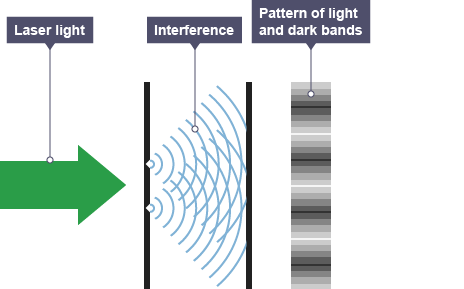 Light allowed to pass through both slits displays a wave-like pattern
Light allowed to pass through both slits displays a wave-like pattern
A travelling particle can be described by a wavefunction, its behaviour is wave-like. Whilst a particle interacting with some other system behaves like a particle. Thus we describe the act of forcing a photon or an electron to act like a particle as ?collapsing the wavefunction? simply because it can no longer be mathematically modelled as a wave.
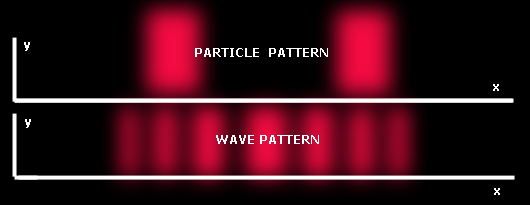
It?s actually wrong to describe matter or light as a particle and a wave. It?s more accurate to say that both can be modelled as a wave and a particle. In reality, light is neither. The concept of particle and wave duality was staggering enough for light, but the double-slit experiment can be conducted with electrons, which display the same duality in nature.
Simulating the Double-Slit Experiment
Rather than wax on about the finer points of Young?s double-slit experiment, I?ll use a computer simulation to show how it?s performed, the results it yields and what this tells us about the nature of matter. As mentioned above, when reading the phrase collapse of the wavefunction, this refers to an electron switching from a wave-like behaviour to a particle-like behaviour. For example, the appearance of a single dot on a fluorescent screen is particle-like as we would expect a wave to be ?smeared? across the screen.
We start with a hypothetical apparatus set up as shown below.
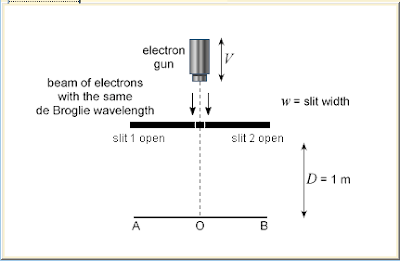 Figure 1: A typical experimental set up of Young?s double-slit experiment
Figure 1: A typical experimental set up of Young?s double-slit experiment
An electron gun fires electrons through two narrow slits onto a fluorescent screen. Where an electron hits the screen a white dot is left behind. We aren?t going to concern ourselves too much with the widths of the slits(1nm) or the energy of the electrons(38V).
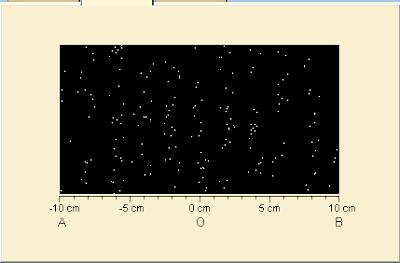 Figure 2
Figure 2
As the electrons stream through the slits one by one they appear on the screen seemingly randomly. In fact, this underlines how the probabilistic nature of quantum physics can still be reconciled with the deterministic nature of classical physics. We cannot predict with any certainty where the next particle will strike the screen, but we can predict with absolute certainty the overall distribution of a large number of electron ?hits?.
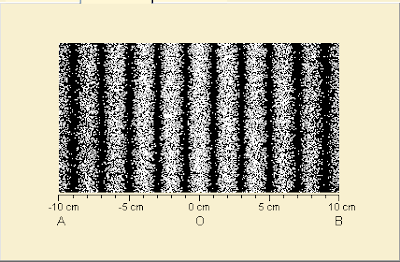
The final distribution shows wide bands of electron hits punctuated with thin black bars showing virtually no elections strikes. These bars don?t line up with the blockages in the screen, and the distribution clearly doesn?t resemble what we would get from firing hard projectiles such as bullets through scaled-up slits where we would expect a graph of the hits to be two ?humps? corresponding to the openings, with some lying between.
Compare that to the graph yielded by our electron firing simulation in Figure 4 below.
 Figure 4
Figure 4
This fringe pattern is destroyed if we run the experiment again, but this time with one of the slits, slit 1 in the case below, closed. Figure 5 below.
 Figure 5
Figure 5
Interference and The De Broglie Waves
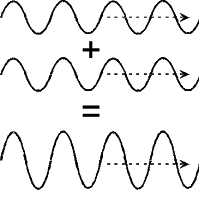 Figure 6: (http://www.phys.uconn.edu)
Figure 6: (http://www.phys.uconn.edu)
The fringe pattern is known as interference. It can be explained easily using an analogy to water waves. When two waves meet at the point of their maxim amplitude the overall amplitude is increased as in Figure 6 The waves are in phase.
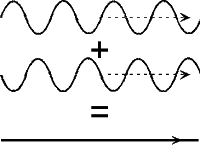 Figure 7: (http://www.phys.uconn.edu)
Figure 7: (http://www.phys.uconn.edu)
When two waves meet with maximum amplitude and minimum amplitude, the waves cancel. Unsurprisingly, this is destructive interference. Figure 7 The waves are said to be out of phase.
These patterns are achieved every time this experiment is conducted. And it?s important to note that it doesn?t matter whether the experiment is conducted in the presence of researchers or in an empty lab. The same results are always obtained.
Even though the precise build is random and probabilistic, the final distribution is deterministic and fully predictable. Remember this, it?s crucial for later when we reassess the consciousness/wavefunction collapse hypothesis.
These wavefunctions, known as de Broglie waves, are a mathematical interpretation of how a particle propagates through space, they are composed of all the possible positions of the particle at any time and the probability of finding a particle at that particular point. In what follows you?ll see why it?s necessary to describe the propagation of a particle through space as a wave function.
The Profound Bit
In an attempt to understand these effects in the above experiment, we reopen both slits and turn down the current of the electron gun to allow one electron at a time to hit the screen. Remarkably the fringe pattern returns, albeit slowly, defying the idea that it is the wave function of one electron is interfering with its neighbour. In fact, it?s clear that the electron interferes with itself.
Stop laughing at the back!
The consequence of this is we are forced to abandon the classic idea of a particle possessing a single defined trajectory through space. The particle can be considered passing through each slit, with the contribution of each slit in the wave pattern causing constructive and destructive interference.
How does physics explain this? Well?. we can?t. We can offer interpretations of this phenomena, such as the Copenhagen interpretation which states that quantum systems don?t possess definite properties prior to measurement, only probabilities that reduce to certainties on measurement.
There are other interpretations such as many-worlds interpretation, but it?s the Copenhagen interpretation I?m most comfortable with. There is good experimental evidence to support the idea that quantum qualities become definitive only upon measurement. Einstein argued against this and suggested quantum systems contain hidden variables in his EPR arguments, which were countered by Bell?s inequalities and later answered by a modification of the same known as the CHSH inequality. As I don?t want to digress too much I won?t discuss those further here, but it?s well worth a Google search if just to see how even opposition to an idea in science can sometimes strengthen and refine that idea.
So, we?re left with an ambiguity, a hole in our carefully crafted quantum science. You may imagine this is where quantum woo merchants begin their machinations as that?s often the tactic of the pseudoscientist. To insert pseudoscience into a gap in conventional understanding. But, in actuality, it is in our attempts to resolve this ambiguity and obtain what we refer to as ?which way information?, that our quantum woo merchants operate.
Obtaining ?Which Way? Information
 Figure 8: A photo gun is added to our experimental set up to obtain ?which way information?
Figure 8: A photo gun is added to our experimental set up to obtain ?which way information?
In an attempt to resolve the mystery of which slit the electron passes through, we introduce a new element to our experimental setup. We scatter photons off the electrons to see if the electron is in the vicinity of slit 1 or slit 2 and follow their path to the fluorescent screen.
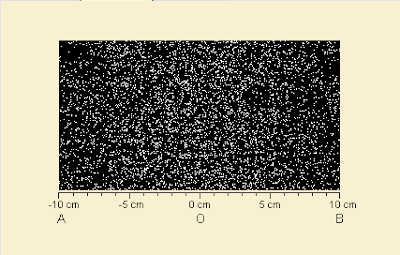 Figure 9
Figure 9
Figure 9 &10: When we observe the results from this test on our fluorescent screen the interference pattern is gone, replaced by a distribution that is just the sum total of particles passing through the slit. The wavefunction now collapses prior to reaching the screen.
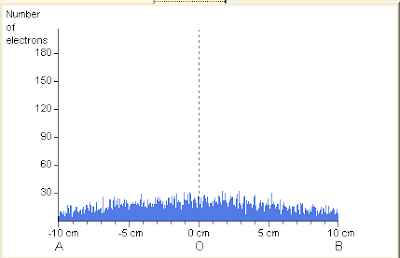
It is as if our act of observation itself caused the wavefunction to collapse, and this is most certainly the quantum-woo merchant?s interpretation of this experiment. This brings us to our first misunderstanding many have of quantum physics and this informs every conclusion they reach following this.
It is not the presence of the conscious observer that collapses the wavefunction, it?s the action they perform on the system that causes the wavefunction collapse. It is also vital to note that these are the results that are obtained whether researchers are present as the experiment is conducted or they have retreated to the Dog and Duck for a pint.
So what is causing the change in the particle?s behaviour?
In the example given above, when electrons are fired at a fluorescent screen, when we bombard the electrons with photons the interaction changes the state of the system catastrophically as, despite lacking mass, photons do carry momentum.
Mathematically we can show this quite easily. If the wave is made of a superposition sum of all the possible states of the particle with constants that represent the probabilities of finding the particle in any of an infinite amount of positions, the probabilities of these possible locations must be 1 as the particle is certain to be somewhere. Therefore if we make the probability of one of these possible states 1 by locating the particle. This reduces the other probabilities to zero. Thus, the wavefunction ?collapses? from a superposition to a simple value.
I?ve shown this below crudely in a form that describes a ?which slit? superposition.
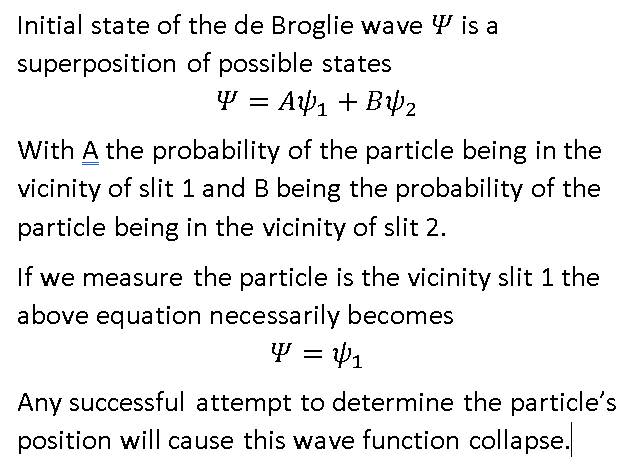
An easy way to understand this physically is by analogy.
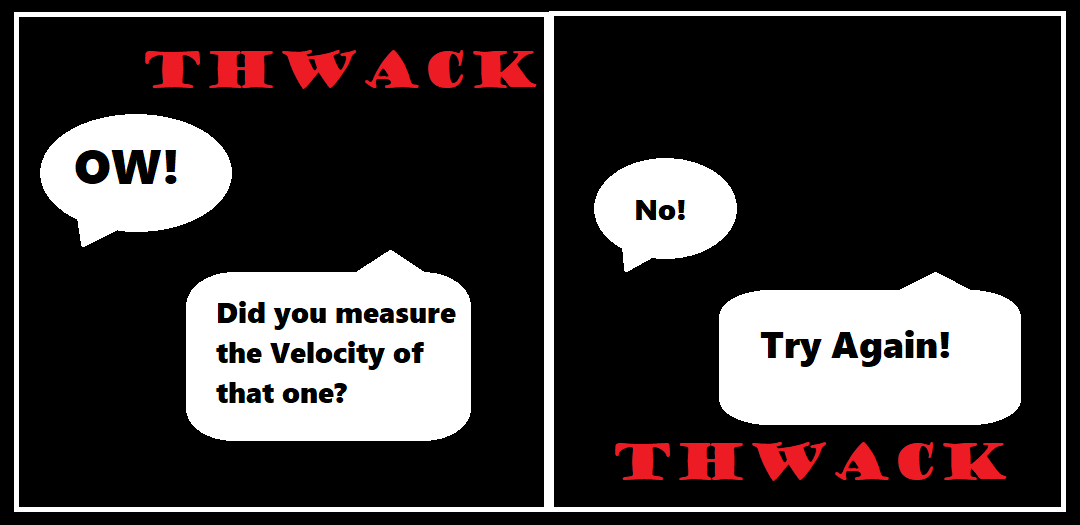
Imagine me asking you to determine the location of tennis balls I?m firing into a darkened room. The only instrument I?m going to give you to do this is a tennis racket. There?s no way of you doing this without fundamentally changing the state of the ball. You may be able to give me the position and velocity of the ball at impact, but you would find it impossible to give me information about the ball after impact. The act of measurement has destroyed the information you had, there is no way you can violently examine that system without changing it fundamentally.
Forming a hypothesis for consciousness-led wavefunction collapse.
Earlier I stated that I believe I can show that the double-slit experiment disproves the idea that consciousness can change the behaviour of matter and light. First, let?s try and collect together what proponents of the idea claim and shape into some form of rough working hypothesis. It?s important to do this as this is what we should be aiming to disprove experimentally.
The QC Hypothesis
Consciousness can exist separately from matter. This consciousness can be shown to have a physical effect in the collapse of the de Broglie wavefunction of a travelling particle. Consciousness is otherwise physically imperceptible. This effect this best shown in Young?s double-slit experiment.
Let?s question for a second what we would expect to find if the double-slit experiment was repeated in a world in which the QC hypothesis is true.
An unavoidable consequence of the fact that we can?t detect or protect our experiment from incursions and interactions by disembodied consciousness is that we should expect that there would be occasions in which the wavefunction collapses for no discernible reason.
It would be as if we?d attempted to gather which way information with the later addition of a photon source and a conscious observer, despite us doing no such thing. If the QC hypothesis were true we would expect to see random wavefunction collapses. This has never been shown to happen. The results of the double-slit experiment are consistent. Researchers don?t record spontaneous wavefunction collapse.
It is that consistency that strongly implies that the QC hypothesis is incorrect in some way. Either consciousness does not exist separate from matter, or consciousness is not responsible for wavefunction collapse.
Or possibly both.

